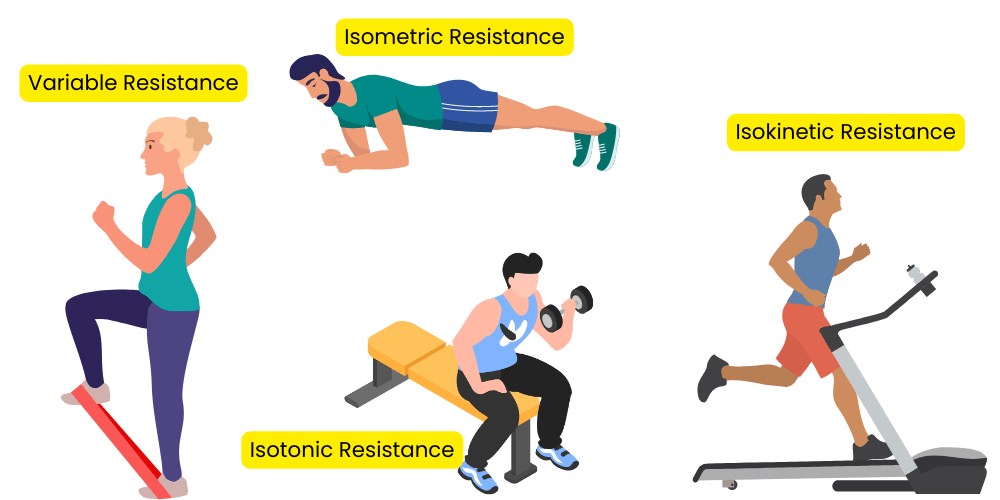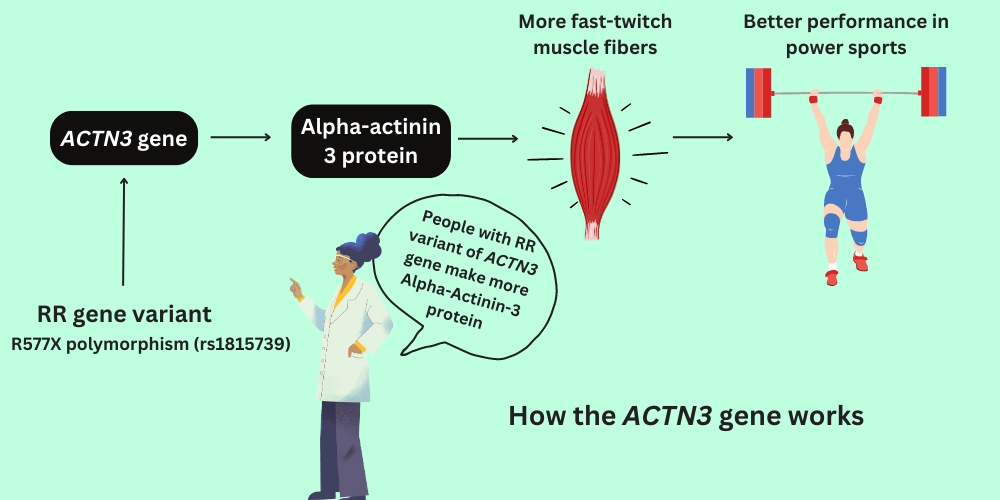Understanding Resistance Training: A Comprehensive Guide

Table of Contents
Resistance training is a term that is often thrown around in fitness circles, but what does it really entail?
This comprehensive guide is designed to provide in-depth knowledge of resistance training, its benefits, its relationship with genetics, and its applicability to different conditions and activities.
What is Resistance Training?
Resistance training, also known as strength training, is a type of physical exercise that involves applying external resistance to muscles to induce muscle contraction. This leads to increased muscle mass, strength, endurance, and tone. It also improves bone strength and metabolic rate.
The “resistance” can come in various forms, such as free weights (dumbbells and barbells), resistance bands, or one’s own body weight. The aim is to challenge the muscles by creating tension, which stimulates muscle growth and enhances strength.
Is Resistance Training the Same as Weight Training?
While the terms resistance training and weight training are often used interchangeably, they aren’t exactly the same.
Weight training is a subcategory of resistance training. It specifically involves the use of free weights or weight machines.
On the other hand, resistance training is a broader term that encompasses exercises using various types of resistance, such as resistance bands, suspension equipment, or body weight.
Does Resistance Training Burn Fat?
Yes, resistance training does help burn fat. When you engage in resistance training, you build muscle mass. Muscle is metabolically active, meaning it burns calories even when you are at rest.
This increase in muscle mass boosts your basal metabolic rate (BMR), causing you to burn more calories throughout the day, thereby promoting fat loss.
Additionally, resistance training also directly burns calories during the workout session.
What are the Different Types of Resistance Training?
Resistance training can be categorized based on various parameters. Let’s explore them under these sub-headings:
Isometric Resistance
In isometric resistance training, the muscle length does not change and there’s no visible movement at the joint. The exercises involve static positions, such as planks or wall sits.
Isotonic Resistance
Isotonic resistance involves moving your muscles through a range of motion. This category includes most traditional strength training exercises like bicep curls, squats, and bench presses.
Isokinetic Resistance
Isokinetic exercises are performed with machines that control the speed of contraction within the range of motion. This type of resistance training is often used in rehabilitative settings.
Variable Resistance
Variable resistance training involves changing the resistance level throughout the range of motion to match the strength curve for a particular exercise, often using specialized equipment or resistance bands.

Genes that Impact Response to Resistance Training
Genetic variation can significantly affect your response to resistance training. Several genes have been identified that influence muscle mass and strength gains from resistance training.
ACTN3
The ACTN3 gene, often referred to as the ‘sprint gene,’ is crucial for fast-twitch muscle fibers, which are involved in high-speed, power-based movements. There are two primary variants of this gene: R and X. The R variant produce alpha-actinin-3, a protein found only in fast-twitch muscle fibers. The X variant creates a stop signal in the production of this protein.

Individuals with two copies of the R variant (RR) may have an advantage in power and strength-based activities, including certain aspects of resistance training, as they can produce the alpha-actinin-3 protein. Those with the XX genotype, who cannot produce this protein, may have a predisposition towards endurance activities.
IGF1
Insulin-like growth factor 1 (IGF1) is a hormone that plays a crucial role in muscle growth and recovery.
It’s responsible for promoting protein synthesis and blocking protein degradation in muscles, making it a key player in the hypertrophy (growth) process following resistance training.
Specific variants of the IGF1 gene have been associated with higher levels of circulating IGF1 and greater muscle mass.
For instance, people with the “192 bp allele” variant have been shown to experience greater increases in muscle mass in response to resistance training compared to those without this variant.
VDR
The Vitamin D Receptor (VDR) gene is another gene of interest in resistance training. Vitamin D is known for its role in bone health, but it also influences muscle function.

The VDR gene provides instructions for making vitamin D receptors, which bind to vitamin D to activate certain genes.
Specific variants of the VDR gene can impact muscle strength and the anabolic response to resistance training.
For instance, the FokI polymorphism of the VDR gene has been associated with muscle strength, with the FF genotype linked to higher muscle strength compared to the other genotypes (Ff and ff).
MSTN
The myostatin (MSTN) gene produces the myostatin protein, which acts as a regulator of muscle growth. Essentially, myostatin puts the brakes on muscle growth, preventing muscles from becoming excessively large.
Certain genetic variants can reduce the effectiveness of myostatin, leading to increased muscle growth.
This means that people with these variants might experience greater muscle mass gains from resistance training. However, such variants are rare and the research in this area is still in the early stages.
Here’s a simple SNP table that summarizes some of the key SNPs in genes related to resistance training:
| Gene | SNP | What It Does |
|---|---|---|
| ACTN3 | rs1815739 | This SNP in the ACTN3 gene influences the type of muscle fibers we have. The R allele is associated with a higher proportion of fast-twitch muscle fibers and potentially better performance in power and strength-based activities. |
| IGF1 | rs35767 | This SNP in the IGF1 gene affects the levels of IGF1. The “C” allele is associated with higher circulating levels of IGF1, which could contribute to muscle growth in response to resistance training. |
| VDR | rs2228570 (FokI) | This SNP in the VDR gene impacts how vitamin D influences muscle function. The “F” allele has been linked to greater muscle strength compared to the “f” allele. |
| MSTN | rs1805086 | This SNP in the MSTN gene can affect the production of myostatin, a protein that regulates muscle growth. The “G” allele might be associated with a reduced myostatin function and potentially greater muscle mass. |
Remember that these SNPs are just a small part of the story. The interactions between different genes, as well as the influence of environmental factors like diet, sleep, and exercise, also play a crucial role.
Non-Genetic Factors that Affect Response to Resistance Training
While genetics play a role, non-genetic factors significantly affect your response to resistance training as well. These include age, sex, nutritional status, sleep quality, stress level, training volume, intensity, and frequency.
For example, proper nutrition and adequate protein intake are crucial for muscle repair and growth. Likewise, inadequate sleep or high-stress levels can hinder recovery and muscle growth.
How Does Resistance Training Prevent Osteoporosis?
Resistance training is beneficial in preventing osteoporosis.
Osteoporosis is a condition that weakens bones, making them fragile and more likely to break. It often occurs as people get older, when their bodies have a harder time creating new bone tissue.
It puts stress on the bones, stimulating the cells that form new bone material. This process helps increase bone density and reduce the risk of osteoporosis.
Improve Response to Resistance Training Based on Your Genes
Genetic insights can be leveraged to optimize the effectiveness of your resistance training. Here’s how you can tailor your approach based on your genetic predispositions:
Understand Your Genetic Profile
The first step to improving your response to resistance training based on your genes is to understand your genetic profile.
Genetic testing can provide insights into how your body is likely to respond to resistance training, helping you adapt your workout regimen accordingly.
The presence or absence of certain genetic variants can inform your approach.
For example, if you have the RR genotype for the ACTN3 gene, which is associated with power and strength, you might excel in activities that require explosive movements.
In contrast, those with the XX genotype may find greater success with endurance-based resistance training.
Customize Your Training Plan
Once you understand your genetic profile, you can tailor your training to align with your genetic predispositions.
If your genetic profile suggests a potential for greater muscle growth (like the “192 bp allele” variant in the IGF1 gene), you might consider incorporating a higher volume of resistance training into your routine to take advantage of this potential.
In contrast, if you have a genetic predisposition that might limit muscle growth (like certain variants of the MSTN gene), you might consider focusing more on other aspects of fitness, such as endurance or flexibility, while still incorporating resistance training for its numerous health benefits.
Adapt Nutrition and Recovery Practices
Your genes can also influence how you recover from exercise and how your body responds to certain nutrients – both of which can impact your results from resistance training.
For example, some people may have a genetic predisposition that affects their protein metabolism.
These individuals might need a higher intake of dietary protein to effectively build and repair muscle tissue after resistance training.
Your genes can also impact how you respond to certain supplements commonly used in conjunction with resistance training.
For instance, variants in the CYP1A2 gene can influence how you metabolize caffeine, a common ingredient in pre-workout supplements.
If you’re a slow metabolizer, too much caffeine can lead to jitters and poor sleep, which could hinder recovery.
Monitor and Modify
Even with genetic insights, it’s important to remember that genes are not destiny. They simply provide a piece of the puzzle.
Monitor your progress and listen to your body. If a certain approach isn’t producing the expected results, don’t be afraid to modify it.
Work with a fitness professional who can help translate your genetic insights into a personalized training plan.
Regular fitness assessments can also help track your progress and adjust your plan as necessary.
Remember, while genetics can influence your response to resistance training, they don’t determine it entirely.
Other factors such as diet, sleep, stress, consistency of training, and effort level also play a significant role.
Which Resistance Training System is Most Appropriate for Hypertensive Clients?
Hypertensive clients need to be careful when choosing a resistance training system.
Hypertension, or high blood pressure, can put a strain on the cardiovascular system, so it’s crucial to opt for a resistance training system that doesn’t excessively raise blood pressure.
Low-to-Moderate Intensity Resistance Training
Low-to-moderate intensity resistance training is a safe and effective approach for hypertensive individuals.
By keeping the intensity lower (around 50-70% of one-rep max), the cardiovascular demand is reduced, lowering the risk of blood pressure spikes during the workout.
The American College of Sports Medicine recommends a higher number of repetitions (10-15 reps per set) at this lower intensity for hypertensive clients.
Circuit Training
Circuit training could be a good option for hypertensive clients. It involves performing a series of exercises, one after the other, with minimal rest in between.
This format allows for both cardiovascular and strength training benefits.
The key for hypertensive clients is to choose exercises that aren’t overly strenuous, keep the weights lighter, and avoid holding their breath during exercises (Valsalva maneuver), which can increase blood pressure.
Strength Training with Blood Pressure Management
Strength training can be integrated with blood pressure management techniques. Breathing exercises, for instance, can help control blood pressure.
Hypertensive clients should be encouraged to breathe naturally during exercises and avoid holding their breath.
Additionally, maintaining a relaxed grip (avoiding clenching the fists) during exercises can prevent unnecessary increases in blood pressure.
Supervised Training
Hypertensive clients should preferably train under the supervision of a fitness professional, who can monitor their response and modify the training program accordingly.
They should also be regularly checking their blood pressure and communicating with their healthcare provider to ensure their training program is not negatively affecting their hypertension.
Regular Aerobic Exercise
Resistance training should be paired with regular aerobic exercise, which has been proven to help lower blood pressure. Activities could include walking, jogging, cycling, or swimming.
Section Summary
It’s important for hypertensive clients to get a medical clearance before starting a new exercise program. While resistance training can be safe and beneficial for hypertensive individuals when done correctly, it should be part of a larger lifestyle management approach, including a healthy diet, regular aerobic exercise, stress management, and regular check-ups with their healthcare provider.
Is Yoga Resistance Training?
While yoga isn’t typically categorized as resistance training, it does involve a significant amount of strength and can improve muscle tone and strength.
In yoga, you use your body weight as resistance to challenge your muscles.

Is Swimming Resistance Training?
Swimming can be considered a form of resistance training as the water provides resistance against your movements.
However, it’s generally not as effective as traditional resistance training methods for building muscle mass, but it can help improve muscle endurance and strength.
Summary
-
What is resistance training?
Resistance training is a type of physical exercise that involves challenging muscles by creating tension, leading to increased muscle mass, strength, endurance, and tone.
-
Is weight training the same as resistance training?
Weight training is a subcategory of resistance training that specifically involves the use of weights.
-
Does resistance training help burn fat?
Yes, resistance training builds muscle mass, which in turn boosts metabolism and promotes fat loss.
-
Are yoga and swimming forms of resistance training?
Yoga and swimming can involve elements of resistance training as they use body weight and water resistance, respectively. However, they typically don’t build muscle mass as effectively as traditional resistance training.
-
How does resistance training prevent osteoporosis?
Resistance training stimulates the cells that form new bone material, increasing bone density and reducing the risk of osteoporosis.
-
Can genes affect response to resistance training?
Yes, certain genes can influence muscle mass and strength gains from resistance training. Genetic testing can provide insights into how your body may respond to resistance training.
Cited Work
- Peterson, M. D., Rhea, M. R., & Alvar, B. A. (2005). Applications of the dose-response for muscular strength development: a review of meta-analytic efficacy and reliability for designing training prescription. Journal of Strength and Conditioning Research, 19(4), 950-958.
- Clarkson, P. M., & Devaney, J. M. (1992). ACTN3: A genetic influence on muscle function and athletic performance. Exercise and Sport Sciences Reviews, 40(1), 30-34.
- Kraemer, W. J., & Ratamess, N. A. (2005). Hormonal responses and adaptations to resistance exercise and training. Sports Medicine, 35(4), 339-361.
- Layne, J. E., & Nelson, M. E. (1999). The effects of progressive resistance training on bone density: a review. Medicine & Science in Sports & Exercise, 31(1), 25-30.
- Westcott, W. L. (2012). Resistance training is medicine: effects of strength training on health. Current Sports Medicine Reports, 11(4), 209-216.
Written By
Share this article












